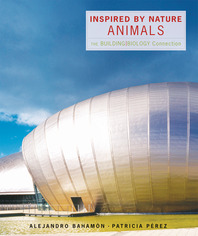
Inspired by Nature: Animals
The Building/Biology Connection
3 April 2009
Territory Rights — Worldwide including Canada, but excluding the British Commonwealth.
Description
A look at how nature serves as a source of inspiration for contemporary architecture.
Nature has always furnished stimulating ideas for the design of architecture, and the use of animal forms in contemporary architecture—whether to endow a project with symbolism, find a functional solution, or simply for aesthetic reasons—has become a commonplace practice. Inspired by Nature: Animals focuses on specific analogies, comparing and contrasting techniques and materials used in animal constructions with examples of human architecture. It gathers together the work of two dozen architects who have drawn on such structures as tortoise and snail shells, spiders’ webs and birds’ nests, beehives and beaver lodges.
Among the built examples from around the world are inventive projects such as Elephant Skin House (PPAG Architects, Austria), Kiss the Frog! (mmw architects, Norway), Moore Apiary (Marlon Blackwell, Cashiers, North Carolina), Concrete Pod (Kazuya Morita Architecture Studio, Nagoya, Japan), and more, beautifully illustrated in colorful photographs supplemented by plans. The visual analogies underline how architects can find elegant solutions and create new, sustainable, and efficient architectonic forms by the close and understanding observation of nature.
Among the built examples from around the world are inventive projects such as Elephant Skin House (PPAG Architects, Austria), Kiss the Frog! (mmw architects, Norway), Moore Apiary (Marlon Blackwell, Cashiers, North Carolina), Concrete Pod (Kazuya Morita Architecture Studio, Nagoya, Japan), and more, beautifully illustrated in colorful photographs supplemented by plans. The visual analogies underline how architects can find elegant solutions and create new, sustainable, and efficient architectonic forms by the close and understanding observation of nature.
Reviews
"A vivid, top pick for any architectural library." — California Bookwatch
"[A] thoughtful investigation of the myriad ways designers are influenced by their surroundings." — John Hill, Daily Dose of Architecture







